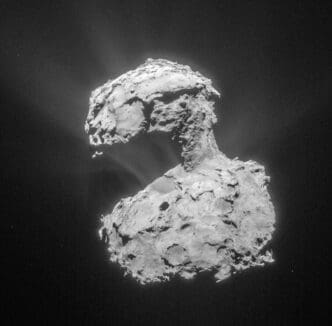A recent study suggests that the water in Earth’s oceans may have origins linked to comets, reigniting the debate about the role these celestial bodies played in supplying our planet with water.
Researchers have discovered that the water on Comet 67P/Churyumov-Gerasimenko shares a similar molecular signature with Earth’s ocean water. This finding challenges previous assumptions, suggesting that Jupiter-family comets might have contributed to Earth’s water supply. The presence of water was crucial for the emergence and sustenance of life on Earth, and understanding its source remains a topic of scientific curiosity. While it’s known that some of Earth’s water may have come from volcanic vapor, which condensed and fell as rain, and from asteroids and possibly comets, the exact contributions of each source are still being debated.
The hypothesis that comets played a significant role in delivering water to Earth is supported by the observation of a key molecular signature in comet water, the deuterium-to-hydrogen (D/H) ratio. Deuterium, a heavier isotope of hydrogen, is less common in water on Earth than in colder environments where comets are believed to have formed. The similarities between the D/H ratios in certain comets and Earth’s water suggest a possible connection.
However, a 2014 analysis of data from ESA’s Rosetta mission presented a new perspective. The mission’s measurements indicated that Comet 67P had a much higher concentration of deuterium compared to Earth’s oceans. This finding initially cast doubt on the idea that Jupiter-family comets substantially contributed to Earth’s water. But new statistical techniques have allowed researchers to re-evaluate Rosetta’s data, isolating deuterium-rich water signatures and considering the impact of cometary dust on measurements.
The presence of dust in a comet’s coma—the cloud of gas and dust surrounding it—can affect the accuracy of water measurement readings. As a comet approaches the Sun, surface ice with deuterium may attach to dust particles and be released into the coma, skewing the readings toward higher deuterium levels than are actually present in the comet’s nucleus. By accounting for this dust effect, researchers concluded that previous measurements might not have accurately represented the comet’s true water composition.
Kathleen Mandt from NASA’s Goddard Space Flight Center emphasizes the importance of these findings, suggesting that revisiting past comet observations and refining measurement techniques could improve our understanding of the solar system’s history. The research team highlights how the dust impact on deuterium readings could unveil more about the potential relationship between comet water and Earth’s oceans, providing further insights into the conditions of early solar system formation.
This research has opened new avenues for understanding the potential sources of Earth’s water, suggesting comets may have had a more significant impact than previously thought. Future comet studies and improved data analysis techniques could further illuminate the origins of Earth’s oceans.
Source: Science.nasa ˙ Youtube







